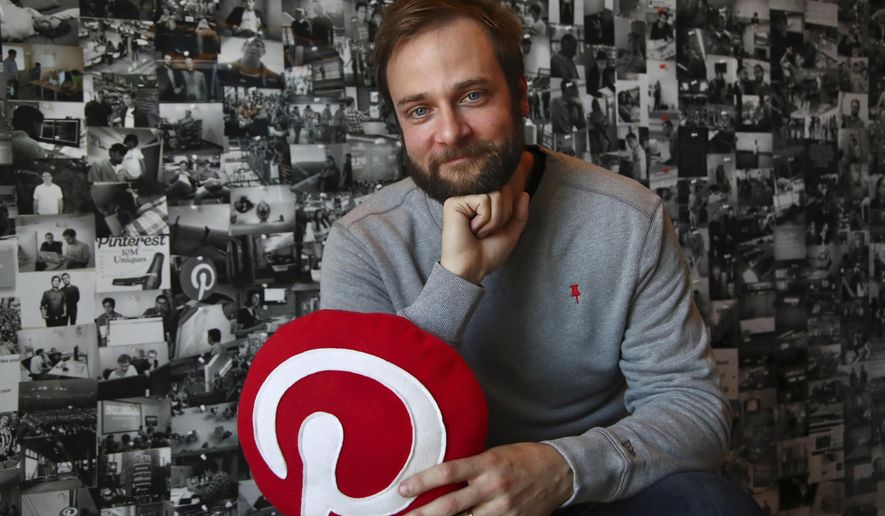NEW YORK (AP) - If Instagram is the dream vacation you’ll never go on and Facebook is Thanksgiving with too many relatives arguing over politics, Pinterest is sitting on the couch by yourself, watching a home-improvement show and absent-mindedly flipping through an old issue of Gourmet magazine.
Pinterest has long shunned being labeled a social network. Because of that, it doesn’t push users to add friends or build connections the way rivals have done to grow quickly. But while this has meant that Pinterest is smaller than, say, Twitter, Instagram and Facebook, the service has also avoided much of its peers’ troubles around misinformation, hate and abuse.
“Social media is about sharing what you are doing with other people,” Evan Sharp, Pinterest’s co-founder and chief product officer said in an interview. “Pinterest isn’t about sharing. It’s mostly about yourself, your dreams, your ideas for what you want for your future.”
That means not bugging you to add friends and see whom you know. Comments are there, but not essential. If you want, you can do Pinterest all alone.
Still, if Pinterest is to start selling shares to the public, as it’s widely expected to in the coming year, potential investors will be looking at how much money it makes and how much it will grow. In another step toward revenue growth, the company announced Tuesday that it is making more of its “pins” - the photos and illustrations users post and save for inspiration - “shoppable.”
The 8-year-old company has a deliberate, slower growth mentality - as opposed to, say, Facebook’s “move fast and break things.” But it’s hard to tell how much of this slower growth is truly deliberate rather than a sign that Pinterest is merely a niche service.
“Sometimes slow and steady can win the race,” said Andrew Lipsman, an analyst at research firm eMarketer. Given mistakes hyper-growth social media companies have made over the years, he added, “maybe there is actually an advantage in this, once you get yourself out of that Silicon Valley mindset.”
Pinterest’s main goal is discovery and inspiration, catching people at big life moments such as weddings, their first kid or first apartment - and everything in between - to help them find ideas of what an outfit, a meal or a dream home might look like. It’s a visual search app, too, letting users find related objects by taking photos of stuff in real life.
Pinterest was founded in 2010 by Sharp and Ben Silberman. It was different from the start. The San Francisco-based service attracted women from the Midwest and central United States, rather than young people, Silicon Valley insiders and nerds in the know.
Even back then, it was reminiscent of Oprah’s O Dream Boards, a place where you “envision your best life” through a digital billboard of sorts. The business strategy is to make the boards something more than pretty things to look at. The boards would feature something to buy, something to make, something a business would want to get in front of a potential customer in the form of an advertisement.
With Tuesday’s announcement, users who’ve been pinning collections of wedding dresses, welcome mats or wool slippers will now be able to see prices and links to retailers’ websites to buy them. While Pinterest already had such “buyable pins” where people could buy stuff, the company says these new “product pins” cover many more products and will be easier to find.
In addition, if the exact item is not available, Pinterest is making it easier for people to find similar ones. While a brown leather couch is a brown leather couch when you type it out in text, it is more complex when it comes to images. When you’re looking for that perfect leather couch, you simply know when you see the right one. Pinterest wants to be the company that will show it to you even when you can’t put it in words to type it into a search engine.
Though Pinterest doesn’t take a cut when people buy stuff through pins, it makes advertising revenue when businesses promote pins in users’ feeds.
EMarketer estimates that Pinterest will grow 45 percent next year to more than $1 billion. The service has 250 million users, compared with 335 million for Twitter and over 1 billion for Instagram.
Pinterest says users feel happy and optimistic about the future when they use the service, even if there may be less of them, at least for now.
Pinterest might have kept people happy by simply avoiding social media’s mistakes.
“By not creating a public forum, they have avoided a lot of the downsides,” Lipsman said. “Generally there is a more positive, upbeat vibe to it. It’s not a place where people might feel bad about themselves.”
An initial public offering of stock, and how Pinterest does afterward, might show whether the tradeoff was worth it.




Please read our comment policy before commenting.